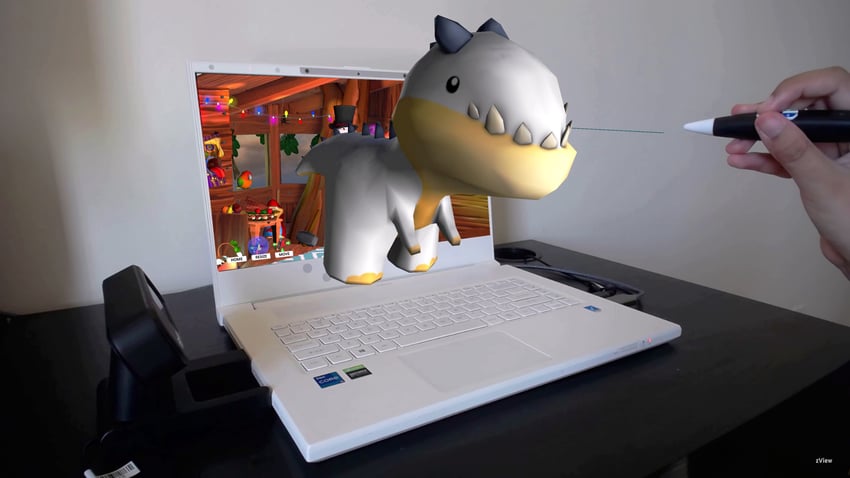Empowering Students with Special Needs Through zSpace Technology

Technology is rapidly transforming how we approach education, and innovative tools can make all the difference for students with special needs. One such tool is zSpace, an immersive learning platform that combines augmented reality (AR), virtual reality (VR), and 3D modeling. By creating interactive, engaging learning experiences, zSpace offers unique opportunities for students with special needs to access and benefit from education in ways that traditional teaching methods might not.
In this blog post, we’ll explore how zSpace can be a game-changer for students with special needs, providing them with personalized, hands-on experiences that foster academic growth and emotional development.
What is zSpace?
zSpace is an immersive educational technology that integrates virtual and augmented reality. It allows students to interact with 3D content in real time. The platform includes a 3D screen and a stylus that users can use to manipulate objects and environments. Whether exploring scientific concepts, solving math problems, or studying the human body, students can engage with the material in a dynamic, tactile way that fosters deeper understanding and retention.
How zSpace Benefits Students with Special Needs
- Engaging Different Learning Styles Students with special needs often have unique learning preferences and challenges. zSpace’s interactive, hands-on approach caters to visual, auditory, and kinesthetic learners, offering a multisensory learning experience. For students with learning disabilities or those on the autism spectrum, this approach can help maintain focus and enhance understanding by making abstract concepts more concrete and engaging.
- Promoting Individualized Learning Many students with special needs benefit from learning at their own pace, which is a challenge in a traditional classroom setting. zSpace allows students to progress through lessons at a speed that suits them, offering the flexibility to revisit material as often as needed. Additionally, teachers can customize lessons to meet the individual learning goals of each student, providing a tailored educational experience that can better address their unique strengths and areas for growth.
- Improving Social Skills and Communication Social interactions can be a significant hurdle for students with autism or other communication challenges. zSpace provides virtual environments where students can practice social situations in a safe, controlled setting. Whether working collaboratively on a project or navigating a simulated social scenario, students can build important communication and social skills without the pressure of real-world consequences.
- Enhancing Focus and Motivation Many students with special needs, particularly those with ADHD or other attention-related issues, can find it challenging to remain focused on traditional classroom tasks. zSpace’s immersive 3D experiences capture students’ attention in a way that textbooks and lectures may not. This heightened engagement often increases motivation to complete tasks and explore new subjects.
- Building Cognitive and Problem-Solving Skills zSpace isn’t just about interacting with 3D models. It also promotes critical thinking. Students can solve puzzles, engage with virtual simulations, and manipulate 3D objects to test hypotheses and see the results of their actions. These activities help build cognitive skills, improve problem-solving abilities, and develop spatial awareness—all vital for academic and personal growth.
- Fostering Independence For many students with special needs, one of the goals of their education is to build independence. zSpace allows students to learn autonomously, exploring concepts and solving problems without relying on constant teacher intervention. As students gain confidence in interacting with the material and accomplishing tasks independently, they develop a sense of achievement and independence that extends beyond the classroom.
Practical Applications in the Classroom
- Science Education: Students can explore virtual ecosystems, dissect animals, or study the solar system without needing physical materials or laboratory space. zSpace allows for safe, immersive science experiments that might be too costly or impractical in traditional settings.
- Mathematics: Abstract math concepts, like geometry or algebra, can be brought to life through 3D visualizations. Students can manipulate shapes and equations in real time, improving their understanding of mathematical relationships and structures.
- Social Studies: Virtual field trips and interactive history lessons allow students to explore historical events, places, and figures in ways that static textbooks simply can’t replicate.
- Life Skills and Therapy: Virtual scenarios on zSpace can help students practice life skills, such as managing money, grocery shopping, or handling conflict. For students with social-emotional needs, this can provide valuable practice in a safe and supportive environment.
Supporting Teachers with zSpace
While zSpace offers incredible benefits for students, it also provides valuable support to educators. Teachers can track individual student progress, identify areas where students may need extra help, and create customized lessons tailored to each student’s needs. By monitoring engagement and performance in real time, teachers are better equipped to adjust their instruction and offer targeted support.
Conclusion
zSpace has the potential to revolutionize education for students with special needs by making learning more engaging, accessible, and personalized. Through its immersive, interactive technology, students can engage with complex concepts, develop critical skills, and gain independence in a way that traditional learning methods may not allow. For teachers, zSpace provides a versatile and supportive tool to cater to diverse learning styles and abilities. As schools continue to explore the benefits of this technology, zSpace offers an exciting avenue for unlocking the full potential of students with special needs, helping them succeed academically and in life.